Research News
-
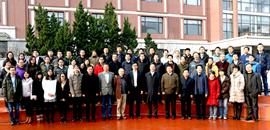 12 22, 2016The Launch of National Key R&D Project Nano Issue “Nano - Catalysis Technologies and Industrial Demonstration of Small Molecule Resources for High - Efficiency Transformation” Was Held in DICP
12 22, 2016The Launch of National Key R&D Project Nano Issue “Nano - Catalysis Technologies and Industrial Demonstration of Small Molecule Resources for High - Efficiency Transformation” Was Held in DICP
On December 17th, 2016, the launch of National key R&D project Nano issue "Nano-Catalysis Technologies and Industrial Demonstration of Small Molecule Resources for High-Efficiency Transformation" was held in DICP. Director YAN Jinding (Basic research management center of Ministry of science and technology), Prof. LIU Zhongmin (Academician of CAE), Prof. SHEN Wenjie (DICP), Prof. XIE Zaiku (China Petrochemical Corp.), Prof. LI Jun (Tsinghua University) are members of the expert advisory group. The attendees include more than 30 people as principal investigators or representatives from the project. The expert group heard reports from the project leader Prof. ZHANG Tao and other subject leaders and gave some specific suggestions for the implementation of the program.
An efficient activation of the chemical bonds with oriented recombination of small molecular resources, such as CO, H2, CH4 and CO2, is pivotal in the transitioning of natural gas and coal into value-added products and clean energy. This project aims at precise controlled C-C bond coupling and C-O/C-H bond activation in the typical conversion processes of these resources, through the creation of multifunctional catalysts at nanometer, sub-nanometer and even single-atom scales. On the basis of these research works, we intend to establish the industrial demonstration processes of syngas production with lower H/C ratio from CO2 and natural gas, and the selective conversion of syngas into low carbon olefins, aromatics, etc. over self-promoted OX-ZEO bi-functional catalysts.(Text by FAN Sisi and Imaged by LIU Wansheng)
-
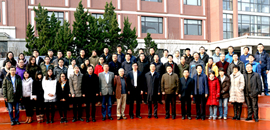 12 22, 2016The Launch of National Key R&D Project Nano Issue “Nano - Catalysis Technologies and Industrial Demonstration of Small Molecule Resources for High - Efficiency Transformation” Was Held in DICP
12 22, 2016The Launch of National Key R&D Project Nano Issue “Nano - Catalysis Technologies and Industrial Demonstration of Small Molecule Resources for High - Efficiency Transformation” Was Held in DICP
On December 17th, 2016, the launch of National key R&D project Nano issue "Nano-Catalysis Technologies and Industrial Demonstration of Small Molecule Resources for High-Efficiency Transformation" was held in DICP. Director YAN Jinding (Basic research management center of Ministry of science and technology), Prof. LIU Zhongmin (Academician of CAE), Prof. SHEN Wenjie (DICP), Prof. XIE Zaiku (China Petrochemical Corp.), Prof. LI Jun (Tsinghua University) are members of the expert advisory group. The attendees include more than 30 people as principal investigators or representatives from the project. The expert group heard reports from the project leader Prof. ZHANG Tao and other subject leaders and gave some specific suggestions for the implementation of the program.
An efficient activation of the chemical bonds with oriented recombination of small molecular resources, such as CO, H2, CH4 and CO2, is pivotal in the transitioning of natural gas and coal into value-added products and clean energy. This project aims at precise controlled C-C bond coupling and C-O/C-H bond activation in the typical conversion processes of these resources, through the creation of multifunctional catalysts at nanometer, sub-nanometer and even single-atom scales. On the basis of these research works, we intend to establish the industrial demonstration processes of syngas production with lower H/C ratio from CO2 and natural gas, and the selective conversion of syngas into low carbon olefins, aromatics, etc. over self-promoted OX-ZEO bi-functional catalysts.(Text by FAN Sisi and Imaged by LIU Wansheng)
-
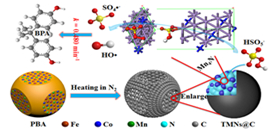 12 19, 2016Researchers in DICP Made a New Progress in Catalyzed Fenton-Like Reaction
12 19, 2016Researchers in DICP Made a New Progress in Catalyzed Fenton-Like Reaction
The sulfate radical-based Fenton-like reaction was firstly reported by Prof. D. D. Dionysiou's group in 2003. Since then, increasing attention has been attracted for the destruction of recalcitrant contaminants in water. Various kinds of transition metal based materials (oxides, MOFs, bimetals and carbides) have been developed and extensively employed as Fenton-like catalysts. However, until now, few studies on the transition metal nitrides (TMNs) for PMS activation have been reported. In the meantime, the PMS activation process catalyzed by nitrogen coordinated metals has never been well illustrated.
The DICP Research Group (DNL2005) led by Prof. WANG Junhu has made a new progress in the research field of catalyzed peroxymonosulfate (PMS) activation for Fenton-like reaction.
Based on the progresses in M?ssbauer spectroscopic studies on Fenton-like reaction mechanism (Catal. Sci. Technol. 2015, 5, 504-514; Appl. Catal. B 2016, 179, 196-205; Catal. Commun. 2016, 77, 32-36), and preparation and exploration of high-performance Fenton-like catalysts (Appl. Catal. B 2016, 181, 788-799; Catal. Sci. Technol. 6, 2016, 7486-7494) as well as the “copolymer-co-morphology” conception proposed for shape-controlled synthesis of Prussian blue analogues and as-derived spinel oxides (Nanoscale 2016, 8, 2333-2342), prof. WANG’s group newly reported a novel strategy for shape-controlled synthesis of graphene encapsulated TMNs (FexMn6-xCo4-N@C) by topotactic transformation of MnyFe1-y[Co(CN)6]0.67·nH2O in N2 atmosphere. The series of FexMn6-xCo4-N@C have significant implications for the removal of bisphenol A by activation of peroxymonosulfate (PMS).
With the cooperation of Prof. AO Zhimin from Guangdong University of Technology, theoretical calculations were carried out to illustrate that the dramatically reduced adsorption energy and facilitated electron transfer for PMS activation catalyzed by Mn4N are the main contributors for the excellent activity of TMNs@C. Prof. SUN Hongqi from Edith Cowan University in Australia also made great contributions to this work. This work details the first insight into versatile TMNs as a catalyst for sustainable environment remediation by activation of PMS and may pave the way towards the development of high-performance Fenton-like catalysts for PMS activation.
The related result was published in ACS Nano (DOI: 10.1021/acsnano.6b07522). The research work is financially supported by the National Natural Science Foundation of China and the Chinese Academy of Sciences Visiting Professorships for Senior International Scientists. (Text and Imaged by LI Xuning)
-
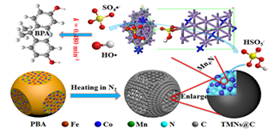 12 19, 2016Researchers in DICP Made a New Progress in Catalyzed Fenton-Like Reaction
12 19, 2016Researchers in DICP Made a New Progress in Catalyzed Fenton-Like Reaction
The sulfate radical-based Fenton-like reaction was firstly reported by Prof. D. D. Dionysiou's group in 2003. Since then, increasing attention has been attracted for the destruction of recalcitrant contaminants in water. Various kinds of transition metal based materials (oxides, MOFs, bimetals and carbides) have been developed and extensively employed as Fenton-like catalysts. However, until now, few studies on the transition metal nitrides (TMNs) for PMS activation have been reported. In the meantime, the PMS activation process catalyzed by nitrogen coordinated metals has never been well illustrated.
The DICP Research Group (DNL2005) led by Prof. WANG Junhu has made a new progress in the research field of catalyzed peroxymonosulfate (PMS) activation for Fenton-like reaction.
Based on the progresses in M?ssbauer spectroscopic studies on Fenton-like reaction mechanism (Catal. Sci. Technol. 2015, 5, 504-514; Appl. Catal. B 2016, 179, 196-205; Catal. Commun. 2016, 77, 32-36), and preparation and exploration of high-performance Fenton-like catalysts (Appl. Catal. B 2016, 181, 788-799; Catal. Sci. Technol. 6, 2016, 7486-7494) as well as the “copolymer-co-morphology” conception proposed for shape-controlled synthesis of Prussian blue analogues and as-derived spinel oxides (Nanoscale 2016, 8, 2333-2342), prof. WANG’s group newly reported a novel strategy for shape-controlled synthesis of graphene encapsulated TMNs (FexMn6-xCo4-N@C) by topotactic transformation of MnyFe1-y[Co(CN)6]0.67·nH2O in N2 atmosphere. The series of FexMn6-xCo4-N@C have significant implications for the removal of bisphenol A by activation of peroxymonosulfate (PMS).
With the cooperation of Prof. AO Zhimin from Guangdong University of Technology, theoretical calculations were carried out to illustrate that the dramatically reduced adsorption energy and facilitated electron transfer for PMS activation catalyzed by Mn4N are the main contributors for the excellent activity of TMNs@C. Prof. SUN Hongqi from Edith Cowan University in Australia also made great contributions to this work. This work details the first insight into versatile TMNs as a catalyst for sustainable environment remediation by activation of PMS and may pave the way towards the development of high-performance Fenton-like catalysts for PMS activation.
The related result was published in ACS Nano (DOI: 10.1021/acsnano.6b07522). The research work is financially supported by the National Natural Science Foundation of China and the Chinese Academy of Sciences Visiting Professorships for Senior International Scientists. (Text and Imaged by LI Xuning)
-
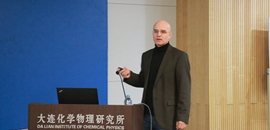 12 16, 2016Prof. Rainer Lehmann from University Hospital of Tuebingen Visited DICP, CAS
12 16, 2016Prof. Rainer Lehmann from University Hospital of Tuebingen Visited DICP, CAS
On December 1st-13rd, 2016, Prof. Rainer Lehmann visited Dalian Institute of Chemical Physics (DICP), Chinese Academy of Sciences. He is Academic Director at the Central Laboratory, University Hospital Tuebingen, Germany and is a specialist in Clinical Chemistry and Pathobiochemistry. His responsibilities encompass managing the daily high throughput analyses of all kinds of clinical samples in the central laboratory (ca. 35,000 analyses per day), the development of new methods, as well as the investigation of pre-analytical aspects. In addition he is the head of the research group “functional metabo-lipidomics” at the Institute of Diabetes Research and Metabolic Diseases (IDM) of the Helmholtz Centre Munich at the University of Tuebingen (part of the German Center for Diabetes research, DZD).
During his stay at the DICP, Prof. Lehmann and researchers from the laboratory of high resolution/separation analysis and metabonomics (Group 1808) at the DICP comprehensively discussed achieved results of their cooperation, and defined specific arrangements for future work, including research plan, paper preparation and project application. In the morning of Dec.12nd, Prof. Lehmann gave a lecture entitled “Crucial factors affecting the outcome of clinical metabolomics studies”. This research was one of the joint projects in this fruitful Sino-German cooperation. Pre-analytical factors affecting the reliability of clinical metabolomics results were introduced in detail, the discovery and validation of a reliable biomarker for sample quality control was demonstrated. He also reported the difference between plasma and serum samples, and notable impact to metabolic profiling of spot urine from the diet the day before. These investigations provide a base for the establishment of standard operation procedures for clinical metabolomics study to improve the sample quality and consequently the outcome of clinical metabolomics investigations. Around 40 staffs and students attended his great lecture.
University of Tuebingen is one of the 11 elite universities (Excellence initiative) in Germany supported in 2012-2017. Its medical college consists of 17 hospitals, 14 research centers and 16 research institutes. Medical research is mainly concentrated in neuroscience, diabetes, immunology, cancer and infectious diseases, these four research directions are components of the German national medical research center.
Two research teams coordinated by Prof. Rainer Lehmann and Prof. XU Guowang, respectively, have been working together since 2008. The two sides combined their respective advantages in the field of medical sciences and pathobiochemistry and analytical chemistry successfully, supported in part by the Sino-German Center. A whole series of research results in establishing standard operation procedures for clinical metabolomics study, on diabetes prevention and control, exercise studies (sports medicine), and development of new method for metabolomics study were jointly achieved. Since 2008, 27 joint papers have been published in international journals, including Clin. Chem., Diabetes Care, Diabetologia, Anal.Chem., Sci.Rep., J.Clin.Endocrinol.Metab. etc.
This visit of Prof. Lehmann will promote the cooperation between the two sides. (Text/LIU Xinyu and Imaged by Xiaoli Hou)
-
 12 16, 2016Prof. Rainer Lehmann from University Hospital of Tuebingen Visited DICP, CAS
12 16, 2016Prof. Rainer Lehmann from University Hospital of Tuebingen Visited DICP, CAS
On December 1st-13rd, 2016, Prof. Rainer Lehmann visited Dalian Institute of Chemical Physics (DICP), Chinese Academy of Sciences. He is Academic Director at the Central Laboratory, University Hospital Tuebingen, Germany and is a specialist in Clinical Chemistry and Pathobiochemistry. His responsibilities encompass managing the daily high throughput analyses of all kinds of clinical samples in the central laboratory (ca. 35,000 analyses per day), the development of new methods, as well as the investigation of pre-analytical aspects. In addition he is the head of the research group “functional metabo-lipidomics” at the Institute of Diabetes Research and Metabolic Diseases (IDM) of the Helmholtz Centre Munich at the University of Tuebingen (part of the German Center for Diabetes research, DZD).
During his stay at the DICP, Prof. Lehmann and researchers from the laboratory of high resolution/separation analysis and metabonomics (Group 1808) at the DICP comprehensively discussed achieved results of their cooperation, and defined specific arrangements for future work, including research plan, paper preparation and project application. In the morning of Dec.12nd, Prof. Lehmann gave a lecture entitled “Crucial factors affecting the outcome of clinical metabolomics studies”. This research was one of the joint projects in this fruitful Sino-German cooperation. Pre-analytical factors affecting the reliability of clinical metabolomics results were introduced in detail, the discovery and validation of a reliable biomarker for sample quality control was demonstrated. He also reported the difference between plasma and serum samples, and notable impact to metabolic profiling of spot urine from the diet the day before. These investigations provide a base for the establishment of standard operation procedures for clinical metabolomics study to improve the sample quality and consequently the outcome of clinical metabolomics investigations. Around 40 staffs and students attended his great lecture.
University of Tuebingen is one of the 11 elite universities (Excellence initiative) in Germany supported in 2012-2017. Its medical college consists of 17 hospitals, 14 research centers and 16 research institutes. Medical research is mainly concentrated in neuroscience, diabetes, immunology, cancer and infectious diseases, these four research directions are components of the German national medical research center.
Two research teams coordinated by Prof. Rainer Lehmann and Prof. XU Guowang, respectively, have been working together since 2008. The two sides combined their respective advantages in the field of medical sciences and pathobiochemistry and analytical chemistry successfully, supported in part by the Sino-German Center. A whole series of research results in establishing standard operation procedures for clinical metabolomics study, on diabetes prevention and control, exercise studies (sports medicine), and development of new method for metabolomics study were jointly achieved. Since 2008, 27 joint papers have been published in international journals, including Clin. Chem., Diabetes Care, Diabetologia, Anal.Chem., Sci.Rep., J.Clin.Endocrinol.Metab. etc.
This visit of Prof. Lehmann will promote the cooperation between the two sides. (Text/LIU Xinyu and Imaged by Xiaoli Hou)